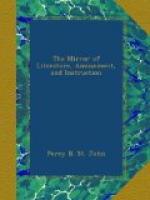MAY.
* * * * *
TEA.
(For the Mirror.)
“The Muses’ friend, tea,
does our fancy aid,
Repress those vapours which the head invade.”
WALLER.
The tea-tree loves to grow in valleys, at the foot of mountains, and upon the banks of rivers, where it enjoys a southern exposure to the sun, though it endures considerable variations of heat and cold, as it flourishes in the northern clime of Peking, as well as about Canton; and it is observed that the degree of cold at Peking is as severe in winter as in some parts of Europe. However, the best tea grows in a mild, temperate climate, the country about Nanking producing better tea than either Peking or Canton, betwixt which places it is situated. The root resembles that of the peach-tree; the leaves are green, longish at the point, and narrow, an inch and half long, and jagged all round. The flower is much like that of the wild rose, but smaller. The fruit is of different forms, sometimes round, sometimes long, sometimes triangular, and of the ordinary size of a bean, containing two or three seeds, of a mouse colour, including each a kernel. These are the seeds by which the plant is propagated, a number, from six to twelve, or fifteen, being promiscuously put into one hole, four or five inches deep, at certain distances from each other. The seeds vegetate without any other care, though the more industrious annually remove the weeds and manure the land. The leaves which succeed are not fit to be plucked before the third year’s growth, at which period they are plentiful, and in their prime. In about seven years the shrub rises to a man’s height, and as it then bears few leaves, and grows slowly, it is cut down to the stem, which occasions an exuberance of fresh shoots and leaves the succeeding summer. In Japan, the tea-tree is cultivated round the borders of the fields, without regard to soil, but as the Chinese export great quantities of tea, they plant whole fields with it. The tea-trees that yield often the finest leaves, grow on the steep declivities of hills, where it is dangerous and in some cases impracticable to collect them. The Chinese are said to vanquish this difficulty by a singular contrivance. The large monkeys which inhabit these cliffs are irritated, and in revenge they break off the branches and throw them down, so that the leaves are thus obtained. The leaves should be dried as soon as possible after they are gathered. The Chinese are always taking tea, especially at meals; it is the chief treat with which they regale their friends, but they use it without the addition of sugar and milk. Tea was first introduced into Europe by the Dutch East India Company very early in the seventeenth century, and a great quantity of it was brought over from Holland by Lord Arlington and Lord Ossory about the year 1666, at which time it sold for 60s. per pound. Tea exhilarates without intoxication, and its enlivening qualities are equally felt by the sedentary student and the active labourer. Dr. Johnson dearly loved tea, and drank great quantities of this elegant and popular beverage, and so does P.T.W.




